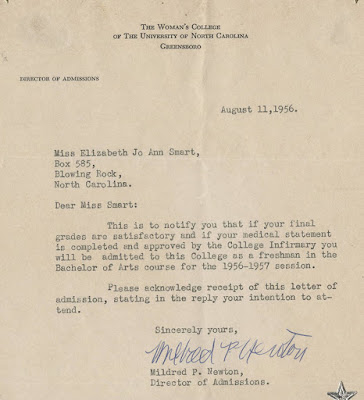This Fall semester marks the 60th anniversary of the desegregation of the student body at the Woman’s College (now UNCG). In the previous two weeks, we explored previous issues related to integrating campus facilities and services. Classes in Fall 1956 began on September 20th, and this week we will look at the debates over desegregation at Woman’s College and in the UNC Consolidated University.
On September 20, 1956 — 60 years ago this week — Fall semester classes began at Woman’s College (now UNCG). And for the first time in its history, the WC student body included two African American women. JoAnne Smart and Bettye Ann Davis Tillman enrolled in the Fall of 1956 as freshmen at WC, becoming trailblazers in the desegregation of the WC campus. Both graduated with the Class of 1960.
Bettye Ann Davis Tillman was a 19-year-old student from Wadesboro, NC. She graduated from the Anson County Training School, a segregated school aimed at providing education for rural African Americans. Tillman was voted “most likely to succeed” by her classmates and graduated as salutatorian of her class.
JoAnne Smart of Raleigh entered WC as a 17-year-old. She was president of her class at the segregated J. W. Ligon School, where she was also a cheerleader and member of the glee club. More on JoAnne Smart (later, Drane) and her experience as a student at WC can be found in this earlier Spartan Stories post.
School officials noted in articles released to media outlets that Tillman and Smart were two of seven African American women who applied for admission to WC. Two applicants did not complete their application in full, and three others “failed to meet scholastic requirements.”
The road to desegregation of the WC campus was not a smooth one. Starting in 1950, public discourse on segregation practices became more common. On the WC campus, a number of faculty members were quite active in encouraging desegregation – of the school and of local businesses. Warren Ashby, a philosophy professor, publicly endorsed school desegregation in a letter to the Greensboro Daily News and led a faculty council resolutions supporting the desegregation of UNC campuses in 1955. He also organized a group of faculty members who regularly met for lunch at the YMCA with faculty members from A&T. WC student leaders also spoke out against segregation, with The Carolinian in 1952 proclaiming segregation to be “legally, morally, and practically wrong.”
In 1951, the Supreme Court ruled that white professional schools had to admit African American students if there was not a comparable segregated black school. Under a ruling by the United States Court of Appeals, three African American men were granted admission to UNC’s School of Law in 1951.
The UNC Consolidated University — which then consisted of UNC Chapel Hill, North Carolina State University, and WC — fought against desegregation of the undergraduate colleges, and it would take lengthy court battles to win African American students access to North Carolina’s predominantly white universities. In 1951, NC State’s Chancellor Harrelson sent a letter detailing instructions for processing the applications of African American students to all of the college’s deans. He noted that while students applying for programs that were not available at historically black colleges had to be considered regardless of their race, African Americans students would not be accepted if they could attend a program at a segregated college.
In a unanimous 1954 decision in Brown vs. Board of Education, the U.S Supreme Court declared that “separate educational facilities are inherently unequal.” But, this case failed to immediately bring about the admission of African Americans to undergraduate programs in North Carolina because higher education was not specifically discussed in the case. In fact, in early 1955, the year after the Brown decision was made and after a number of applications from potential African American students had been received, the Consolidated University System’s Board of Trustees passed a resolution affirming that all three institutions would not accept African American undergraduate students.
In a response to questions from UNC President Gordon Gray, NCSU Chancellor Carey Bostian drafted a form letter, which could be sent to any African American applicant to the UNC schools denying them admission solely on the basis of race. It stated that “The Board of Trustees of the Consolidated University of North Carolina has decided that applications of Negros to the undergraduate schools at the three branches of the Consolidated University will not be accepted. We trust that you will be able to pursue your education at another college.”
On September 16, 1955, however, the Supreme Court ruled in favor of three African American men from Durham who had filed a lawsuit against the UNC Board of Trustees after being denied admission to the undergraduate program in Chapel Hill. They enrolled in 1955. Both NCSU and WC first admitted African American students in Fall 1956.
In discussing why she chose to attend Woman’s College, JoAnne Smart Drane noted, “once I was aware of Brown v. Board of Education, it just seemed to offer a lot of hope for doing things that had not been done previously. And so I realized that this was an opportunity that could be had. So why not pursue it?” She recognized that she had an opportunity due to others who had gone before and fought against the leadership. When asked if she considered herself a trailblazer, she responded, “only in the sense that the opportunity to do what I did could have been done by so many others before me. But those doors were closed, and they did not have the same opportunity … If they had the same privilege, [they] could have gone through the same doors and done even more.”
By Erin Lawrimore



One reply on “Desegregating WC: Tillman, Smart, and the Long Road to Integration”
Excellent article! It makes me (even more) proud to be a staff member of UNCG!